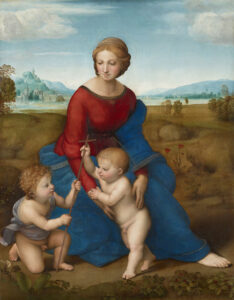
A 4-week virtual lecture series by renowned art historian and well-known Patrons tour guide, Prof. Elizabeth Lev!. We are excited to bring the Vatican Museums to our Patrons, their families and friends during this time!
"Raphael and His World" Lecture Series Themes:
April 25: The Elusive Leonardo
May 2: The Might of Michelangelo
May 9: Clash of the Titans
May 16: Raphael Triumphans, Raphael Moriens
Each episode of this lecture series is free to all Patrons and their invited guests. A special thank you to the New York PAVM Chapter for underwriting this incredible event.
The Elusive Leonardo
Despite being arguably the most famous name in the history of art, Leonardo da Vinci remains a fascinatingly enigmatic figure. Painter without a workshop, scientist without a lab, he nonetheless left his mark everywhere went. No one absorbed more from this Master than Raphael, who was not only inspired by Leonardo’s compositions and color, but also strove to emulate the gentlemanly qualities of the older master. We’ll look at the Last Supper and Mona Lisa to see how Raphael blended Leonardo’s experiments into his own iconic style. The talk will conclude with a discussion of Leonardo’s St Jerome in the Vatican collection, and its recent restoration for the 500th anniversary of that master’s death in 2019.
The Might of Michelangelo
Raphael is recorded in Florence in 1504, the same year that Michelangelo’s towering David was hauled into the Piazza Di Signoria. The 21-year-old painter was amazed by the grandeur of Michelangelo’s style, but wrestled with how to bring that sculptural monumentality into his own sweet style. We’ll look at Michelangelo’s Doni Tondo and his unfinished St Matthew, and see how these innovative designs made their way into Raphael’s repertoire. Raphael also witnessed the showdown that electrified Florence, Leonardo and Michelangelo’s painting duel in the Palazzo Vecchio. Little did Raphael know, that he would be one to take up the brush against Michelangelo when the works were left unfinished…This lecture will also feature an update of the restoration of Raphael’s St Peter and Paul panels, rarely seen works from the apostolic palace.
Clash of the Titans
The championship match between painting and sculpture was never completed in Florence. It took the iron will of Pope Julius II della Rovere, the machinations of Donato Bramante and the pride of Michelangelo to stage the riveting contest of Raphael versus Michelangelo in the Vatican. As Michelangelo frescoed a narrative cycle on a ceiling for the first time in the history of art, Raphael, 25 years old, was redefining mural painting in the Stanza della Segnatura the papal throne room. Raphael’s School of Athens was countered by Michelangelo’s Genesis, but undaunted, the younger painter shot back with the astonishing innovations of the Stanza del Eliodoro. Stroke for stroke, giornata for giornata, this was the heavyweight championship of the history of art. Our appreciation for this greatest of tournaments was increased by the wondrous restorations that revealed intimate details of the technique and process of both masters.
Raphael Triumphans, Raphael Moriens
This last lecture focuses on the apex of Raphael’s career in Rome from 1514 to 1520. Running the equivalent of a Fortune 500 company, friends with prelates and princes, Raphael had it all: fame, money and prestige. Yet the 30 year old painter kept challenging himself with new projects and media. Designing tapestries, mastering oil painting, experimenting with the new technological possibilities of printing, nothing seems to have beneath the interest of his restlessly creative mind. As he shouldered the burden of head architect of St Peter’s, he also turned his attention to Rome’s rich past while cataloguing the ancient ruins for his new patron Pope Leo X Medici. We’ll revel in the dazzling variety of Raphael’s projects – the Vatican Loggia, the Chigi frescoes, the Transfiguration, and the last room of the papal apartments, the Sala del Costantino. In this presentation, we will be the first to see the newly completed restoration of these frescoes, and hear about some of the amazing new discoveries regarding Raphael and his studio.

